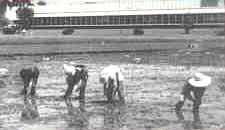Rice bowls shall brim
 SCIENTISTS at the Philippines- based International Rice Research Institute (IRRI) are currently field testing a prototype of a new and sturdier variety of rice on the institute's experimental plots. This new and robust variety shall have thicker grain-bearing stems apart from having greener and more erect leaves. The redesigned plant not only boasts of a healthier look but promises a higher yield of grain (Plant Genetic Resources Newsletter, No 102).
SCIENTISTS at the Philippines- based International Rice Research Institute (IRRI) are currently field testing a prototype of a new and sturdier variety of rice on the institute's experimental plots. This new and robust variety shall have thicker grain-bearing stems apart from having greener and more erect leaves. The redesigned plant not only boasts of a healthier look but promises a higher yield of grain (Plant Genetic Resources Newsletter, No 102).
The new rice plant is superior in several other ways. One of its many pluses is the targeted production of 25 per cent more grains than the current high- yielding varieties. It is also supposed to yield more on the same amount of land, with the same amount of fertilisers and less water. In addition, "the new rice is likely to be directly sown in the soil, a method which cuts labour costs substantially when compared with transplanting", says Gurdev Khush, IRRI'S principal plant breeder.
Scientists at the IRRI say that on irrigated land the new variety should yield 12.5 tonnes (t) per ha. The present-day rice varieties yield 10 t per ha. From the farmer's point of view, an additional 1.25 t per ha will be harvested. It is estimated that this additional grain output will feed at least 450 million more people in the countries of Asia, where rice forms the staple diet.
Out of the 20 to 25 stems of today's high-yielding varieties, only 14 to 15 produce small, rice-bearing panicles. The rest of the stems remain unproductive as mere undesired competitors for nutrition and solar energy. In addition, excessive growth and vegetation creates a humid environment and a moist canopy which favours diseases and insects. On the contrary, the new rice variety bears only six to 10 productive stems. Each stem bears larger particles with 200 to 250 grains. This is remarkable, since a panicle of the present high- yielding varieties bear barely 100 grains.
While thicker, stronger stems of the new variety support the larger panicles, the robust roots hold it firmly to the ground. Thicker, dark green and erect leaves do their share of the job. These trap more sunlight and use it more efficiently. "Single-leaf photosynthesis of the new rice, for example, is 10 to 15 per cent higher than that Of IR72, a modern high-yielding variety", explains Shaobing Peng, IRRI crop physiologist.
The main advantage of the new variety is, evidently, its capacity to produce more grain than straw. While current high-yielding varieties produce a plant biomass of 20 t per ha, with grain and straw in a 50-50 ratio, the new rice plant produces a biomass of 21 t per ha, with grain and straw in a 60-40 ratio. Having more grain than straw can be attributed to larger panicle size and fewer stems.
Since there are fewer stems, the new rice plants grow closer together. This in turn replaces the usual practice of transplanting rice saplings with broadcasting of seeds. This reduces labour and water requirements greatly.
"By planting the new rice closer and establishing a dense canopy, it will be possible to suppress weed growth, which should lead to a reduction in herbicide use", says Keith Moody, IRRI agronomist. This is significant in view of the growing concern for the adverse effects of chemical herbicides on environment and health. With the new rice variety still in its infancy, farmers are likely to obtain access to it in the next five years.
